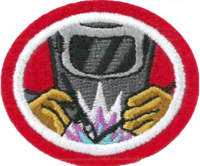Difference between revisions of "AY Honors/Welding/Requirements 2/es"
(Created page with "</noinclude>Completar con éxito un mínimo de tres horas de instrucción.* <noinclude>") |
(Created page with "</noinclude>Fuente de alimentación SMAW <noinclude>") |
||
| Line 15: | Line 15: | ||
<noinclude></noinclude><section end=req2b /></b> | <noinclude></noinclude><section end=req2b /></b> | ||
| − | :<b>c. <section begin=req2c /><noinclude> | + | :<b>c. <section begin=req2c /><noinclude></noinclude>Fuente de alimentación SMAW |
| − | </noinclude>SMAW | + | <noinclude></noinclude><section end=req2c /></b> |
| − | <noinclude | ||
| − | |||
:<b>d. <section begin=req2d /><noinclude><div lang="en" dir="ltr" class="mw-content-ltr"> | :<b>d. <section begin=req2d /><noinclude><div lang="en" dir="ltr" class="mw-content-ltr"> | ||
Revision as of 13:48, 17 May 2021
Nivel de destreza
3
Año
1978
Version
30.12.2025
Autoridad de aprobación
División Norteamericana
1. Completar con éxito un mínimo de tres horas de instrucción.*
2. Identificar las siguientes herramientas:
- a. Careta de soldar
- b. Alambre de soldadura GMAW
- c. Fuente de alimentación SMAW
- d.
Welding gas regulator
- e.
GMAW welding torch
- f.
220-volt electrical outlet
- g.
PAC torch
3.
Explain the following terms:
- a.
Fusion welding
- b.
Electrode
- c.
Oxidation
- d.
Slag
- e.
Alloy
4.
Select and describe one fusion welding process.
- a.
How is heat generated?
- b.
Why is filler metal added?
- c.
Describe how the molten metal is protected from oxidation.
5.
Name at least one thermal and one mechanical cutting process.
- a.
Describe how each one works.
- b.
Discuss relative advantages and limitations of each.
6.
Demonstrate a knowledge of risks and hazards associated with welding and cutting, and the steps to prevent or reduce them.
- a.
Electric current
- b.
High temperatures
- c.
Ultraviolet radiation
- d.
Toxic fumes
- e.
Moving machinery/blades
- f.
High-pressure gases
7.
Describe the safety gear required for various fusion welding and cutting processes.
- a.
Head/eye protection
- b.
Clothing
- c.
Gloves
- d.
Hearing
- e.
Filtration/ventilation
8.
For either the GMAW or SMAW welding process, demonstrate an ability to use welding guidelines, such as handbook tables, to select the appropriate welding process parameter settings, including proper amperage and electrode type/size for various types and thicknesses of a selected metal.
9.
Explain and demonstrate proper equipment setup and consumables selection for at least one welding process.
10.
Describe all the components of the equipment to be used and their function.
11.
Using the designated processes, perform the following:
- a.
PAC: Make one straight cut at least three inches long in mild steel or aluminum
- b.
SMAW: Complete i and ii, or complete iii.
- i.
Make two bead-on-plate welds at least two inches total length
- ii.
Make one square-groove weld in the flat position
- iii.
Make one corner weld in the flat position
- c.
GMAW: Complete i and ii, or complete iii.
- i.
Make two bead-on-plate welds at least two inches total length
- ii.
Make one square-groove weld in the flat position
- iii.
Make one lap weld in the flat position
Note:
* Must pass a knowledge exam upon completion.
^ These are minimum requirements; additional welding is encouraged


